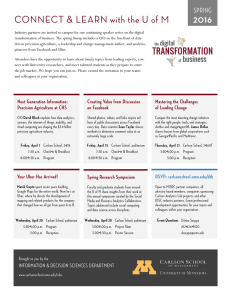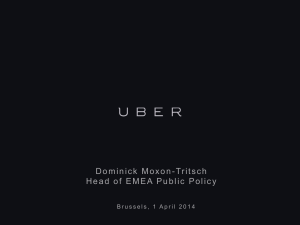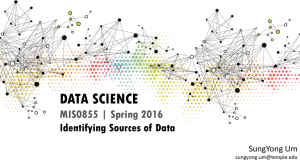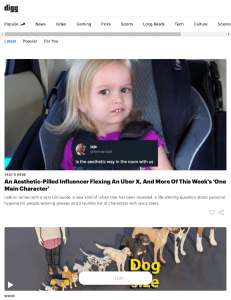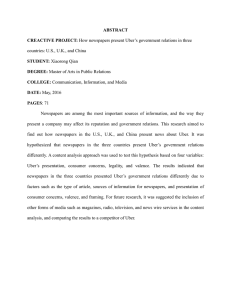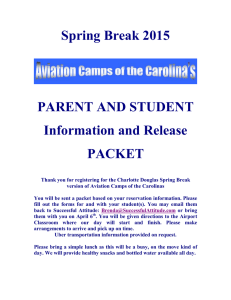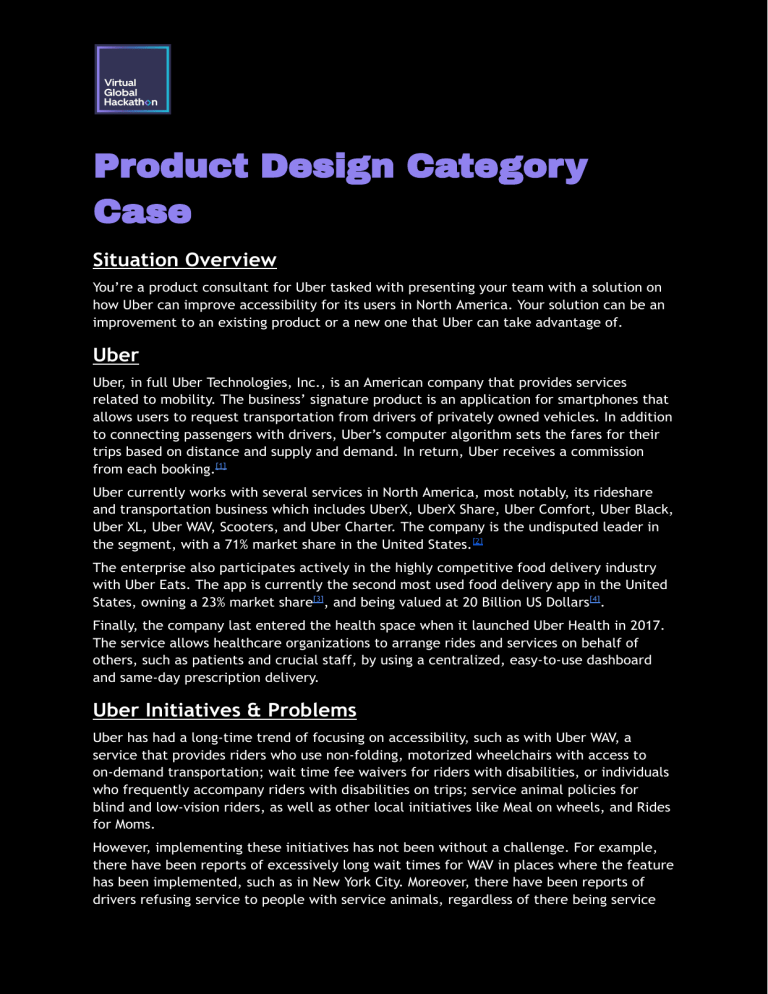
Product Design Category Case Situation Overview You’re a product consultant for Uber tasked with presenting your team with a solution on how Uber can improve accessibility for its users in North America. Your solution can be an improvement to an existing product or a new one that Uber can take advantage of. Uber Uber, in full Uber Technologies, Inc., is an American company that provides services related to mobility. The business’ signature product is an application for smartphones that allows users to request transportation from drivers of privately owned vehicles. In addition to connecting passengers with drivers, Uber’s computer algorithm sets the fares for their trips based on distance and supply and demand. In return, Uber receives a commission from each booking.[1] Uber currently works with several services in North America, most notably, its rideshare and transportation business which includes UberX, UberX Share, Uber Comfort, Uber Black, Uber XL, Uber WAV, Scooters, and Uber Charter. The company is the undisputed leader in the segment, with a 71% market share in the United States.[2] The enterprise also participates actively in the highly competitive food delivery industry with Uber Eats. The app is currently the second most used food delivery app in the United States, owning a 23% market share[3], and being valued at 20 Billion US Dollars[4]. Finally, the company last entered the health space when it launched Uber Health in 2017. The service allows healthcare organizations to arrange rides and services on behalf of others, such as patients and crucial staff, by using a centralized, easy-to-use dashboard and same-day prescription delivery. Uber Initiatives & Problems Uber has had a long-time trend of focusing on accessibility, such as with Uber WAV, a service that provides riders who use non-folding, motorized wheelchairs with access to on-demand transportation; wait time fee waivers for riders with disabilities, or individuals who frequently accompany riders with disabilities on trips; service animal policies for blind and low-vision riders, as well as other local initiatives like Meal on wheels, and Rides for Moms. However, implementing these initiatives has not been without a challenge. For example, there have been reports of excessively long wait times for WAV in places where the feature has been implemented, such as in New York City. Moreover, there have been reports of drivers refusing service to people with service animals, regardless of there being service animal policies and a process for reporting a service animal denial, as well as account deactivations based on disability-related cancellations.[5] What to Submit 1. PDF (Word Document or Slides) outlining your team’s proposed solution. Prototypes or design of the solution must also be included within submission. Submission Requirements 1. Regional qualifying submissions must be at maximum 6 slides/pages and should be submitted as a PDF. 2. 6 teams per region (5) for this category will be qualified (30 teams total). The top two (2) teams per region (5) for this category will be invited to compete in the Regional Round and represent their region (10 teams total). The top team (1) per region (5) for this category will be invited to represent their region by competing in the global final (5 total teams). The top 3 teams for this category will be declared winners. Teams WILL be able to make changes to the slides submitted in the regional qualifying round. 3. Submissions can be a maximum of 6 slides/pages, excluding the (optional) appendix, title, and thank you slides. An appendix may be included in the submission after the ‘core slides’ and can contain additional market research or models that can be referred to ONLY during the regional video submissions and Q&A with the judges. The appendix itself will not be marked. Each team may have a maximum of five (5) appendix slides. Any slides in the appendix after the fifth will be discarded. Teams will have a chance to include or change the appendix for both regional and global final rounds. Do NOT include videos. They will not transfer into a PDF for the regional qualifying round and will not be allowed to be played during the live or video round. Slide animations can be included, but will not be transferred into a PDF for the regional qualifying round or global live finals, so will only be used for the regional finals video. 4. Each team’s title slide must include ALL of the email addresses registered for that team in the bottom left-hand corner and the team name. If you do not include this information as your identifier, the submission will be disqualified and you will NOT be permitted to submit another version. 5. Naming your PDF: UGH_ProductDesign_TeamName_Region Submission Details 1. Use this link to submit your solution 2. PDF submission deadline for regional qualifiers is on September 20 (GMT-0), 23:59 3. Regional finalists announcements are on September 27 (GMT-0), 23:59 Judging Criteria Rubric Creativity & Innovation Description Uniqueness: Demonstrates a novel and innovative feature concept for the company Originality: Presents a fresh and creative idea that differentiates itself from existing solutions Outside-the-box-thinking: Shows a creative approach in addressing customer needs and enhancing the product Value Proposition & Benefits Clear value proposition: Clearly articulates the unique value that the feature brings to the customers and the company Customer benefits: Demonstrates how the feature addresses customer needs and provides tangible benefits Business potential: Demonstrates the potential impact of the feature on the company's growth, revenue, or market share Feasibility of Business Recommendations Practicality: Proposes practical and realistic recommendations Implementation plan: Provides a clear plan for implementing recommendations Scalability: Considers the scalability potential of the feature, accommodating future growth and user demand Structure & Clarity of Ideas Logical flow: Ideas and arguments follow a logical and coherent structure Clear communication: Ideas and analysis are communicated clearly Organization and formatting: Presents analysis in a well-organized and visually appealing manner Score (0 to 5) FAQs Q: My team has decided to change the category we are competing in. Is there anything we have to do? A: No! If your registered team has decided to change which category you want to compete in, it’s fine - just indicate what category you are competing in when submitting your pdf on typeform! Q: Is there any specific content structure for the slides? A: While there is NOT a defined structure for the slide presentation, we suggest the following order: 1 slide identifying the problem 2 slides explaining the product or feature and why it’s impactful 1 slide explaining the implementation plan 1 slide explaining the scalability of the feature 1 slide explaining results projection Be aware that this is strictly a recommendation, your team is allowed to utilize your slides as you see fit with your proposal. Q: Can my solution include an area that Uber doesn’t currently act in? A: Yes, your solution can include areas where Uber does not currently work in, but make sure that you are addressing the area of concern, North America. Q: Will the design of my slide presentation be evaluated? A: The design of your proposal will not be taken into consideration in your team’s grade assignment. However, design is a central part of transmitting your ideas, which is essential for the judge’s comprehension of your proposal. Q: Am I expected to focus on specific types of accessibility needs, or should my solution be inclusive of all user groups? A: The decision is up to your team. You may choose to address a certain need or take into account multiple user groups. Q: How much research am I expected to conduct and back up my solution with? A: While your team may start off with the information provided in this document, it is recommended that you research the issue which your team is targeting in further detail, such that you are able to sufficiently back up the reasoning for your solution. Q: Should I take Uber’s current and possible competitors into consideration? A: Only If your team believes there’s significance in mentioning possible competitors that should be addressed, as it’ll count toward the problem addressing scenario. If there aren’t any significant competitors, that should be mentioned too in case your team finds it relevant. Q: Do I have to account for my solution’s development budget and its legality? A: While we don’t expect you to account for exact numbers, we do expect that you take the solution’s financial feasibility into consideration. Furthermore, it is recommended that you take a brief look into the legality of your solution, in order to ensure its feasibility and implementation.
